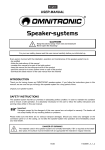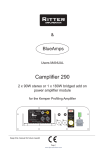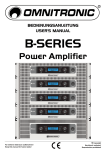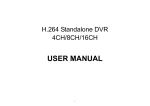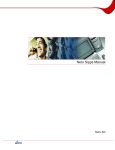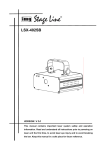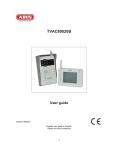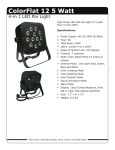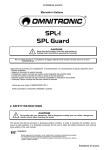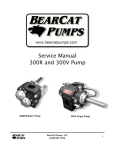Download User Manual
Transcript
USER MANUAL Active speaker-system CAUTION! Keep this device away from rain and moisture! Unplug mains lead before opening the housing! For your own safety, please read this user manual carefully before you initial start-up. Every person involved with the installation, operation and maintenance of this device has to - be qualified - follow the instructions of this manual - consider this manual to be part of the total product - keep this manual for the entire service life of the product - pass this manual on to every further owner or user of the product - download the latest version of the user manual from the Internet INTRODUCTION Thank you for having chosen an OMNITRONIC speaker-system. If you follow the instructions given in this manual, we are sure that you will enjoy this device for a long period of time. Unpack your speaker-system. SAFETY INSTRUCTIONS This speaker-system has left our premises in absolutely perfect condition. In order to maintain this condition and to ensure a safe operation, it is absolutely necessary for the user to follow the safety instructions and warning notes written in this user manual. Important: Damages caused by the disregard of this user manual are not subject to warranty. The dealer will not accept liability for any resulting defects or problems. Please make sure that there are no obvious transport damages. Should you notice any damages on the connection panel or on the casing, do not take the speaker-system into operation and immediately consult your local dealer. DANGER OF BURNING! The materials used in this speaker-system are normally flammable. If B1 is required at the installation place, the surface must be treated with an appropriate fire retardant in regular intervals. DANGER TO LIFE! 18/30 00029746.DOC, Version 1.3 A crashing speaker-system can cause deadly accidents. All safety instructions given in this manual must be observed. Before the speaker-system is switched on all faders and volume controls have to be set to "0" or "min" position. CAUTION: Turn the amplifier on last and off first! HEALTH HAZARD! By operating speaker-systems with an amplifier, you can produce excessive sound pressure levels that may lead to permanent hearing loss. Keep away children and amateurs! There are no serviceable parts inside the speaker-system. Maintenance and service operations are only to be carried out by authorized dealers. OPERATING DETERMINATIONS This speaker system is a passive system which must only be used for permanent installations. This product is only allowed to be connected with an appropriate power amplifier and was designed for indoor use only. The given maximum power of the speaker system describes short-term peaks the system can handle as a maximum. The correspondent RMS power is - as of all comparable systems (also from other manufacturers) - significantly lower. The maximum power of the speaker system must never be exceeded. When operating the speaker system, please make sure that the loudspeakers always sound well. When distortions can be heard, either the amplifier or the loudspeaker is overloaded. Overloads can quickly lead to amplifier or speaker damage. In order to avoid damage, please reduce the volume immediately when distortions can be heard. When speaker systems are destroyed by overload, the guarantee becomes void. By operating speaker systems with an amplifier, you can produce excessive sound pressure levels that may lead to permanent hearing loss. Please refer to the explanations under "Legal instructions". WARNING! Speaker systems must only be operated by trained persons. Danger of Life due to crashing speaker systems or hearing loss due to excessive sound pressure levels! The different local conditions have to be considered in terms of safety rules. This speaker system must never be operated or stockpiled in surroundings where splash water, rain, moisture or fog may harm the speaker system. When using smoke machines, make sure that the speaker system is never exposed to the direct smoke jet and is installed in a distance of 0.5 meters between smoke machine and speaker system. The ambient temperature must always be between -5° C and +45° C. Keep away from direct insulation (particularly in cars) and heaters. The relative humidity must not exceed 50 % with an ambient temperature of 45° C. This speaker system must only be installed at a solid, plane, anti-slip, vibration-free, oscillation-free and fireresistant location. Please note: when using this speaker system in public or industrial areas, a series of safety instructions have to be followed that this manual can only give in part. The operator must therefore inform himself on the current safety instructions and consider them. This device is only allowed for an installation via the mounting bracket. In order to safeguard sufficient ventilation, leave 50 cm of free space around the device. 19/30 00029746.DOC, Version 1.3 Before installing the system, make sure that the installation area can hold a minimum point load of 5 times the system's load (e.g. weight 20 kg - point load 100 kg). DANGER! This speaker system must never be stacked - Danger to Life due to crashing speaker systems! DANGER! This speaker system must never be suspended - Danger to Life due to crashing speaker systems! Operate the speaker system only after having familiarized with its functions. Do not permit operation by persons not qualified for operating the speaker system. Most damages are the result of unprofessional operation! This speaker system is not designed for road use. The speaker system is designed only for seldom transports. When transporting this speaker system, it must be moved carefully and without force. Speaker systems must never be transported with cranes. Never stack heavy objects on this speaker system. Persons must never climb onto this speaker system. Never use solvents or aggressive detergents in order to clean the speaker system! Rather use a soft and damp cloth. Please consider that unauthorized modifications on the speaker system are forbidden due to safety reasons! If this speaker system will be operated in any way different to the one described in this manual, the product may suffer damages and the guarantee becomes void. Furthermore, any other operation may lead to dangers like crashes, hearing loss etc. Legal instructions Operating an amplification system can produce extremely high noise levels that may cause a permanent hearing loss. The legal instructions for using an amplification system vary from country to country. The user must always inform himself on the legal instructions valid in his country and apply them to his situation. Always monitor the sound pressure level when operating an amplification system in discotheques, concerts etc. Never exceed the permissible noise level exposures as specified by your authorities. The monitoring of the noise levels must be documented in an appropriate way. In Germany, the following instructions are binding: Strafgesetzbuch § 223 ff: bundesrecht.juris.de/bundesrecht/stgb TA Lärm: www.umweltdaten.de DIN 15905-5: www.din.de Arbeitsstättenverordnung § 15: www.lgl.bayern.de/arbeitsschutz Berufsgenossenschaftliche Vorschrift BGV B3: www.pr-o.info VDI-Richtlinie: VDI 2058 Blatt 2: www.vdi.de Hearing damage caused by high noise levels can be treated as physical injury and persecuted by law. Please note that the organizer is responsible for keeping to a specified noise level. If this noise level will be exceeded, the event may be cancelled immediately. If the organizer does not fulfil his safety duties, he is reliable by civil law for any damages occurred, e.g.: Pay the treatment costs of the damaged person. Pay a smart money to the damaged person. Economic damage caused can be demanded from the operator of the amplification system. 20/30 00029746.DOC, Version 1.3 If hired persons work with amplification systems: the noise levels of music events are almost always too high. This is why the entrepreneur has to set up warning signs and provide hearing protectors. The staff has to use these. Please note: OMNITRONIC cannot be made liable for damages caused by incorrect installations and excessive noise levels! Information on hearing loss More and more young people suffer from hearing loss of 25 decibel or more, mainly caused by loud music from portable cassette recorders and CD players or discotheques. Everybody operating amplification systems should know to what sound pressure levels he exposes his or the audience's hearing. As an average levels between 75 and 105 dB(A) in the discotheque or 95 and 115 dB(A) at a rock concert are reached. Individual peaks can exceed the pain level at 130 dB(A). Such levels are typical for motor chainsaws or jack hammers. Overview on the different noise levels 10 dB Heartbeat 20 - 30 dB Whisper 80 dB Heavy traffic or telephone ringing 40 dB Average home 100 dB Power mower 50 dB Light traffic 120 dB Boom box in car 60 dB Normal conversation 130 dB Pain level 70 dB Vacuum cleaner 140 dB Jet plane 30 meters overhead 90 dB Pneumatic drill It is important to know that doubling the power increases the noise level by 3 dB. The human hearing does only recognizes a doubling of the sound level when the noise level is increased by 10 dB. Damaging the hearing does not depend on the sound level but on the noise level and starts way before the pain level. Many people deceive themselves by thinking that noise is something they can get accustomed to. It is possible that a positive opinion of a certain noise can reduce the physiological reaction, but the slow impacts on the inner hearing must not be neglected: over stimulation and continuous elimination of the Cortic organ's hair cells. The reason why some people have got accustomed to a certain noise level and are no longer disturbed is that they have already suffered a hearing damage. This damage make the insensitive to those frequencies forming the loudest part of the noise. Getting accustomed to noise does not mean anything other than trying to get along with the hearing loss in everyday life. The hearing loss itself cannot be healed, it can only be compensated by hearing aids. Subjectively, the hearing loss feels like dampened ears. This effect weakens with the time, but a loss in hearing sensitivity often remains. In order to relax the hearing sufficiently, the noise level should not exceed 70 dB(A) for 10 hours. Higher noise levels during this relaxing period can prevent the relaxation and promote a permanent hearing damage (Tinitus) or hearing loss. Therefore: Whoever wants to maintain his hearing should use hearing protectors! START-UP This speaker-system is directly connected with the audio mixer. Make sure that the power switch is set to “OFF”. Before you connect the devices, all units have to be switched off and the master-control is set to “0”. Connections A good cable run improves the sound quality remarkably. Input cables should be short and direct, since high frequencies will mostly be absorbed if the cables are unnecessarily long. Besides that a longer cable may lead to humming and noise trouble. If long cable runs are unavoidable, you should use balanced cables. 21/30 00029746.DOC, Version 1.3 In order to obtain highest sound quality, only use high-quality cables for connecting the devices. Make sure that the cables are properly fixed. Mic In Here, you can connect dynamic microphones via balanced microphone-cables. The microphone signals are connected via the XLR-socket. Occupation balanced XLR-connection: Balanced use with XLR connectors 2 1 3 1 = Ground / Shield 2 = Hot (+) 3 = Cold (-) 1 Input 2 3 Output For unbalanced use pin 1 and pin 3 have to be bridged Occupation jack plug: Unbalanced use of mono 1/4" jack plugs Balanced use of stereo 1/4" jack plugs Tip = Signal (+) Tip = hot (+) Ring = cold (-) Sleeve = Ground / Shield Sleeve = Ground / Shield Tip Tip Sleeve Ring Sleeve Strain relief clamp Strain relief clamp For connection of balanced and unbalanced plugs, ring and sleeve have to be bridged at the stereo plug. Line In The Line In can either be connected via the RCA-sockets (KB-208A) or the balanced XLR mounting-socket. Line Out Connect the Line output via the balanced XLR-plug (except KB-208A). The connection with the next active speaker should be made via a microphone cable. INSTALLATION This speaker-system must only be installed at a solid, plane, anti-slip, vibration-free, oscillation-free and fireresistant location. 22/30 00029746.DOC, Version 1.3 Before installing the system, make sure that the installation area can hold a minimum point load of 5 times the system‘s load (e.g. weight 20 kg – point load 100 kg). The speaker-system must never be installed higher than 100 cm without secondary attachment. Install the desired number of speaker-systems in the room. Every speaker-system features two transportation handles. The speaker-system should be carried without force by two persons of the same size. Carrying the speaker-system as one person alone should be avoided as the high weight and the strain could lead to back damages and torsions. Please note that all speakersystems with more than 25 kg weight must be transported with two persons. Installing and orienting the speaker-system When installing the speaker-system on e.g. a stage, microphones and turntables should always be located behind the speaker-systems. In this way, you can avoid dangerous and unpleasant feedbacks. If you cannot install the speaker-systems this way, the microphones and turntables should be located as far away as possible from the speaker-systems. When using the speaker-system as monitor-system make sure to avoid feedbacks. The speaker-systems of a PA-system are normally located left and right to the stage. Do not install the speaker-systems on the stage, but rather on appropriate tables or platforms in front of the stage. In order to produce a clear sound, the speaker-systems should be installed in a way that they throw the sound over the audience‘s heads. A Full Range speaker-system should be installed at listeners‘ eye level. Please refer to the safety instructions under Installation. Loudspeaker combinations need to be installed bass-middle-high (from bottom to top). Make sure that the membranes of all speakers are in one line vertically and horizontally. Only in this way all frequency ranges are produced at the same time and without any time or phase delays. Always install the speaker-systems in a way that a minimum distance of three meters to the audience is kept. This is the only way to avoid hearing damage for unreasonable listeners. Block the area in front of the speaker-systems with appropriate means. Avoiding feedbacks One of the most frequent problems when operating speaker-systems are feedbacks. They can be recognized by howling and growling loudspeakers. Feedbacks are created then a signal is recorded by a microphone, amplified, played back by a loudspeaker and then again recorded by the microphone. The prerequisite for feedback is that the played back signal is louder than the original signal. A feedback never cover the whole frequency range but only one overboosted frequency. Make sure that you install especially the monitor-speakers so far away from the microphone that another recording of the microphone signal is impossible. Extreme levels like feedbacks, bass-hum or the beats of a dropping microphone can destroy the loudspeakers within very short time and produce immediate hearing damage. Such extreme levels must be avoided at any rate. We recommend to use appropriate equalizers and Compressor/limiters. Stacking DANGER! This speaker-system must never be stacked – Danger to Life due to crashing speaker-systems! This speaker-system may only be installed on the floor or appropriate stage elements etc. 23/30 00029746.DOC, Version 1.3 24/30 00029746.DOC, Version 1.3 Satellite-systems A satellite-system is a system where a speaker-system with flange is installed on top of a subwoofer. The satellite system must always provide enough stability. Satellite systems are only allowed if the subwoofer‘s weight is twice as much as the top speaker‘s weight. Furthermore, the subwoofer‘s base surface must always be sufficiently dimensioned in relation to the top speaker in order to prevent tilting over. The subwoofer and the top speaker must only be connected via an appropriate distance tube and flange. The carrying capacity of the distance-tube must never be exceeded. A satellite system or a combination of speaker system/speaker stand or speaker system/stand must only be installed on the ground! When choosing the installation-spot, please make sure that such an installation has to be installed in a way that no person can enter the area below the system! Make sure that the respective area is blocked. An unintended movement of the load has to be avoided – also in case of fire! The installation is only allowed on carrying areas. In some cases, an appropriate substructure, e.g. via an balancing foot, has to be created. The system must never be moved before the top speaker is uninstalled! When choosing the installation material, optimum dimensions have to be chosen in order to secure maximum safety. Installation on a stand or speaker stand The speaker-system may only be installed on a stand or speaker stand if the original speaker-system is equipped with an appropriate flange. Stands or satellite systems must only be installed on a plane area with a maximum inclination angle of 5°. Caution: Speaker-systems installed on stands or satellite systems may cause severe injuries when crashing! When using stands or satellite systems under the influence of horizontal forces, e.g. through wind, the standing safety can be impaired. This is why additional safety measures like attaching ballast weights have to be taken. If inclined tension cables or prolonged outriggers are used, the area of danger has to be marked or even be blocked. Before lifting or lowering the telescopic tubes, you must always block a safety area around the stand or satellite system. This safety area must have a diameter of 1.5 times the maximum height. Lifted telescopic tubes always have to be secured with a secondary securing! The total weight of the installation (=total weight of all individual parts) must never exceed the maximum load of the installation area. The stand has to be installed out of the reach of people. An unintended movement of the load has to be avoided – also in case of fire! The installer is responsible for adhering to the carrying capacity given by the manufacturer, the safety requirements and the qualification of possible co-workers. 25/30 00029746.DOC, Version 1.3 When people are located below the load, all necessary safety measures have to be taken in order to avoid injury. The personnel has to be instructed on the content of the user manual and on the dangers related with operating stands. Depending upon the individual installation spot, all necessary measures against movement and for securing the standing safety have to be created. The installation is only allowed on carrying areas. In some cases, an appropriate substructure, e.g. via an balancing foot, has to be created. The system must never be moved before the top speaker is uninstalled! When choosing the installation material, optimum dimensions have to be chosen in order to secure maximum safety. Loosen the fixation screws of the legs. Pull the legs out until the cross struts stand at a 90° angle to the legs. Tighten the fixation screws of the legs. DANGER! If installing on slippery surfaces, the legs must be secured with screws or nails via the provided holes or a anti-slippery mat has to be used. Installation of the TV-pin (only for stands) Attach an appropriate TV-pin to the top end of the stand and fasten it with the handle at the side. Installation of the speaker-system Caution: The loads have to be installed in a balanced way. Caution: The carrying capacity of the stand or speaker stand must never be exceeded! Install the speaker-system via the flange on the speaker stand or via the TV-pin on the stand. Make sure that the maximum lifting height of the tube is never exceeded. Lifted telescopic tubes always have to be secured with a secondary securing! 26/30 00029746.DOC, Version 1.3 Installation on a wall-mounting The speaker-system may only be installed on a wall-mounting if the original speaker-system is equipped with an appropriate flange. Before attaching the speaker-system, make sure that the installation area can hold a minimum point load of 5 times the installation‘s weight (e.g. 20 kg weight – 100 kg point load). The durability of the installation depends very much on the material used at the installation area (building material) such as wood, concrete, gas concrete, brick etc. This is why the fixing material must be chosen to suit the wall material. Always ask a specialist for the correct plug/screw combination indicating the maximum load and the building material. The wall-mounting must always be installed via all fixation holes. Do only use appropriate screws and make sure that the screws are properly connected with the ground. Procedure: Step 1: On the wall-mounting, there are 4 holes for the installation. Step 2: Hold the wall-mounting onto the location where it is to be installed. Step 3: Mark the boreholes with a pen or a suitable tool. Step 4: Drill the holes. Step 5: Hold the wall-mounting in the desired position and tighten the screws. Step 6Install the speaker-system on the wall-mounting. The wall mounting‘s maximum service life must never be exceeded. Suspended installation This speaker-system must never be suspended – Danger to Life due to crashing speaker-systems! Installation as floor monitor Attach both monitor feet (except KB-208A) at the rear end of the box. 27/30 00029746.DOC, Version 1.3 OPERATION Make sure that the available voltage is not higher than stated on the voltage selector before you connect the power cord. Connection with the mains Connect the device to the mains with the power plug. The occupation of the connection cables is as follows: Cable Brown Blue Yellow/Green Pin Live Neutral Earth International L N The earth has to be connected! If the device will be directly connected with the local power supply network, a disconnection switch with a minimum opening of 3 mm at every pole has to be included in the permanent electrical installation. The device must only be connected with an electric installation carried out in compliance with the IECstandards. The electric installation must be equipped with a Residual Current Device (RCD) with a maximum fault current of 30 mA. Switch the device on. After switching on the speaker-system, wait 8 to 10 seconds until you turn the volumecontrol in order to avoid speaker-damage. Caution! Increase the level of each channel only so far that the CLIP-LED lights up shortly. Thus, you avoid that the output signal is distorted and your speakers are damaged. When operating the speaker-system, please make sure that the loudspeakers always sound well. When distortions can be heard, either the amplifier or the loudspeaker is overloaded. Overloads can quickly lead to amplifier or speaker damage. 28/30 00029746.DOC, Version 1.3 In order to avoid damage, please reduce the volume immediately when distortions can be heard. When speaker-systems are destroyed by overload, the guarantee becomes void. Always check the sound pressure level with a meter in order to keep to the threshold. If you want to switch off the system, switch off the speaker-system first in order to avoid acoustic shocks on the speakers. CLEANING AND MAINTENANCE The operator has to make sure that safety-relating and machine-technical installations are inspected by an expert after every four years in the course of an acceptance test. The operator has to make sure that safety-relating and machine-technical installations are inspected by a skilled person once a year. The following points have to be considered during the inspection: 1) All screws used for installing the speaker systems or parts of the speaker system have to be tightly connected and must not be corroded. 2) There must not be any deformations on housings, fixations and installation spots (ceiling, suspension, trussing). 3) The electric power supply cables must not show any damages, material fatigue (e.g. porous cables) or sediments. Further instructions depending on the installation spot and usage have to be adhered by a skilled installer and any safety problems have to be removed. 4) If the speaker-system is installed overhead, the inspection must include if the eye-bolts are still well tightened. Otherwise the eye-bolts have to be tightened handtight again. 5) If the speaker-system is secured via clamping belts, the inspection must include if the clamping belts are still well fixed. Otherwise fix clamping belts again. We recommend a frequent cleaning of the speaker system. Please use a soft lint-free and moistened cloth. Never use alcohol or solvents! There are no serviceable parts inside the speaker system. Maintenance and service operations are only to be carried out by authorized dealers. If the speaker system distorts, one of the loudspeakers may be defective. Test the speaker system once more with another amplifier. If the sound remains distorted, the speaker system should not be operated any more in order to prevent further damage. Please contact your dealer. If clacking sounds are heard from the speaker system, screws may have loosened due to the continuous vibrations. The speaker system should be checked by a specialist. Especially for public use, the speaker system should be checked before every operation so that the speaker system and the speakers in the systems are always well fixed. Should you need any spare parts, please use genuine parts. Should you have further questions, please contact your dealer. DANGER TO LIFE! Disconnect from mains before starting maintenance operation! Replacing the fuse If the fine-wire fuse of the device fuses, only replace the fuse by a fuse of same type and rating. Before replacing the fuse, unplug mains lead. Procedure: 29/30 00029746.DOC, Version 1.3 Step 1: Open the fuseholder on the rear panel with a fitting screwdriver. Step 2: Remove the old fuse from the fuseholder. Step 3: Install the new fuse in the fuseholder. Step 4: Replace the fuseholder in the housing. If the power supply cable of this device becomes damaged, it has to be replaced by a special power supply cable available at your dealer. TECHNICAL SPECIFICATIONS Power supply: Fuse: Rated power: Power (max.): Components: Inputs: 1 Mic 1 Line Outputs: 1 Line Out Max. SPL: Impedance: Frequency-range: Dimensions (H x W x D): Weight: KB-208A 115/230 V AC, 50/60 Hz ~ T 2 A, 250 V 80 W RMS 160 W 8" woofer, 1" horn XLR XLR or RCA KB-210A 115/230 V AC, 50/60 Hz ~ T 2 A, 250 V 120 W RMS 240 W 10" woofer, 1.35" horn KB-212A 115/230 V AC, 50/60 Hz ~ T 2 A, 250 V 150 W RMS 300 W 12" woofer, 1.35" horn KB-215A 115/230 V AC, 50/60 Hz ~ T 2 A, 250 V 180 W RMS 360 W 15" woofer, 1.75" horn XLR or balanced ¼" XLR or balanced ¼" XLR or balanced ¼" jack jack jack XLR or RCA XLR or RCA XLR or RCA - XLR or balanced ¼" XLR or balanced ¼" XLR or balanced ¼" jack jack jack 102 dB 110 dB 115 dB 120 dB 4 Ohms 4 Ohms 4 Ohms 4 Ohms 65 Hz - 18 kHz 55 Hz - 18 kHz 50 Hz - 18 kHz 40 Hz - 18 kHz 400 x 277 x 257 mm 510 x 350 x 285 mm 580 x 480 x 325 mm 740 x 555 x 400 mm 8 kg 14 kg 18 kg 27 kg Please note: Every information is subject to change without prior notice. 29.01.2009 © 30/30 00029746.DOC, Version 1.3













